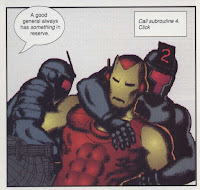by Mike Saenz and Bill Bates
Marvel Comics Graphic Novel, 1988
'Iron Man: Crash' (72 pp) was published as a Marvel Graphic Novel in 1988. Along with the 65 pp graphic novel, there is a 7 page afterward featuring an essay from author Saenz, and descriptions of the computing procedures and software used to create the comic.
Mike Saenz introduced the first computer-drawn comic book, the black and white Shatter, in February 1985 for First Comics. Shatter was composed using a MacIntosh PC. With the advent of the Mac II in 1987, Saenz was interested in using it to compose a more elaborate work, particularly in terms of deploying a full range of color, and arranged with Marvel editor Archie Goodwin to create 'Iron Man: Crash'.
Tony Stark intends to market his latest 'Iron Man' style technology - a sophisticated armor suite called the SAV - for use in industrial applications. Among the potential licensees is a Japanese conglomerate called ESON; Stark's decision to sell the SAV technology to ESON is not well received by Nick Fury, still the driving force at SHIELD, and a man wary of giving the Japanese an advantage in the highly competitive global technology market.
Stark's liberal stance is tested when, on a business trip to Japan to negotiate with ESON executives, he is attacked by unknown assailants.
Rather than taking Nick Fury's advice and flee Japan, Tony Stark decides that he will investigate the attack on his own - as Iron Man. And his newest suit of armor is more than a fighting machine......it possesses an array of devices that allow Stark access to the unique realm of Cyberspace.........
'Iron Man: Crash' is one of the projects that sounded good in the planning, but failed in the execution.
Even by the standards of the time, the artwork not very impressive. Most of the content of the novel was composed using the Mac II's graphics software (QuickDraw) and is necessarily low-res.
A few panels feature more high-res imagery composed using Adobe Illustrator, as well as some CAD images of the Heli-carrier and vertibirds composed using Pro 3D. Regardless of the method used to draw the images, they all have a static, awkward quality that translates rather poorly into the inherently dynamic format of the comic book.
A major drawback to 'Crash' is Saenz's writing. Many panels in the first part of the book are crammed with strings of pretentious 'tech' gobbledygook that's a chore to wade through.
The essay on 'The Making of Crash' that Saenz provides in the book's afterward also suffers from being less about informing the reader of the creative process and more about Saenz positioning himself as a sort of Tech Guru to the ignorant masses.
Given that Saenz' other major PC project during the mid-80s was the game MacPlaymate, which let the user place a Hand Icon onto certain regions of the anatomy of a rasterized drawing of a reclining nude woman (I'm not making this up - see screenshot below), this attitude seems more than a little pompous........
(For another review of 'Crash', see this link.)
The verdict ? 'Iron Man: Crash' is best regarded as an artifact from the pop culture of the late 80s, rather than a groundbreaking addition to the comic book / graphic novel canon.
The PC-generated graphic novel 'Batman: Digital Justice', which was authored by Pepe Moreno, and came out in 1990, is better example of what artists were capable of doing at the dawn of the digital comics era.















.jpg)






















1 comment:
I have to agree with your assessment of "Crash" vs. "Batman: Digital Justice", owning both. Batman was more of a story than Crash, but the hype was so strong around these two products and both being sealed, you could not read them to determine if they were worth the price.
Post a Comment